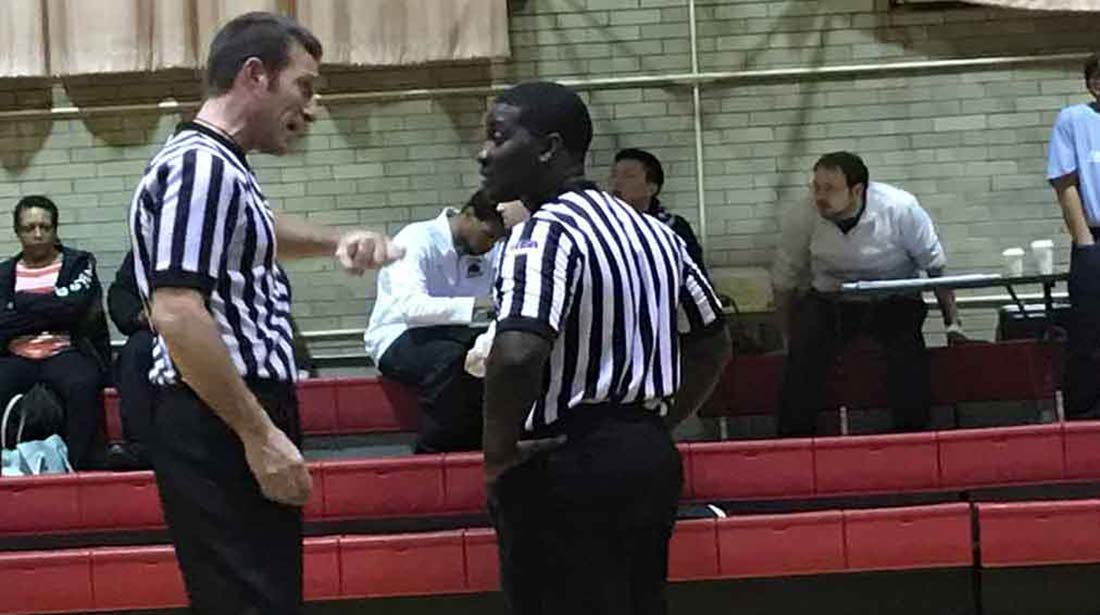By Karl Bullock
They walked out of the Von Steuben gym on Friday night, already an afterthought in the minds of spectators.
Ken Vasser is just fine with that.
On this night, audacious shouts of disagreement travel through the air directed at the black-and-white striped jerseys of Vasser and his fellow official as they dealt with their current task. The game of basketball.
With the blur of bodies on the court, Vasser, a 10-year veteran referee of the Illinois High School Association, was locked into a thousand-yard stare in a calm, collected focus.
“OH MY GOD, HE WAS IN FRONT OF THE LINE,” a short middle-aged woman yelled from the bleachers at a backcourt violation called by Vasser. “He was in front of the line, wasn’t he?” She looked around seeking nods of affirmation, but to no avail.
In the face of criticism, Vasser said fans wouldn’t be able to handle the pressure of his profession.
“You let it roll off you because A, [the fan] isn’t licensed in IHSA basketball and B, if we put you out here in this same situation, you’ll stink up the game,” Vasser said.
Such is the unheralded profession of a referee. There are no expectations. Just show up, do your job and leave. But it’s much more complicated than that.
Referees take on a daunting role of multitasker, facilitating as game manager and arbitrator while controlling the varying emotions of players, coaches and the crowd.
“We make it look easier than it really is,” said David Hamlin, an IHSA basketball official who partnered with Vasser for the night’s game as the Panthers took on Taft.
As the action unfolded on the court, Hamlin called a Taft forward for a shooting foul, awarding free throws to Von Steuben and eliciting an angry response from an opposing fan.
“It can’t hit the rim and you call a foul after. That’s terrible…You know better than that ref,” an older man shouted across the court. There was little concern on the face of Vasser during the one-way exchange. The voices in his head were too loud for him to notice.
“I’m actually talking to myself,” he said. “Is this player legal? Is the offensive player engaged with his defender? Which one is his pivot foot?”
Both refs agreed that while fan interaction is part of the game, there is little tolerance for disrupting play. Hamlin acknowledged there were instances where they’ve had to eject fans for interfering.
“Sometimes you get those fans that just go a little too far and you think, man, these are just high school games,” Hamlin said. “At that point we take that directly to the school administrator to escort them out.”
Another role officials take on is that of an arbitrator. At different points in a game, a coach will see sequences on the court from different angles than the referee.
Exasperated looks on players’ faces are brought on by confusion during a Von Steuben-initiated fast break in the third quarter following a stoppage in play after a push-off foul. Vince Carter, who shares head coaching duties for the Panthers with Marvin Williams, threw his hands up in frustration after officials acted out the foul by way of explanation.
Body contact is a natural occurrence in basketball, but that doesn’t mean coaches are in agreement with officials over both calls and non-calls alike.
Regardless of which team the call may favor, Carter said he looks for referees to be consistent in their officiating. However, he said he knows there is a right way and wrong way to challenging calls, and he’s making an impression on his players with his actions.
“Parents and fans don’t realize while you’re doing all that yelling at the official, it’s making it harder on the players,” Carter said.
Carter’s approach is to pull the official to the side for clarification, a method that Vasser said he is more than willing to oblige.
“We’ll tell him the rule about illegal contact on the shot and what I saw from the angle where I was standing,” Vasser said. “I’ll try to make sure I watch it next time to see if it was the correct call.”
At the end of each game, Vasser opens his journal to make a few notes on his nightly performance, a proactive method on improving his court positioning to allow for better angles to make the correct calls.
“Nobody ever asks a ref that question,” he said pointing out his preparation.
As the clock hits zero, Hamlin and Vasser disappeared into the locker with little notice. The sign of a job well done.
“A well-officiated game, nobody remembers the referees,” Vasser said. “It’s the way I like to keep it.”


